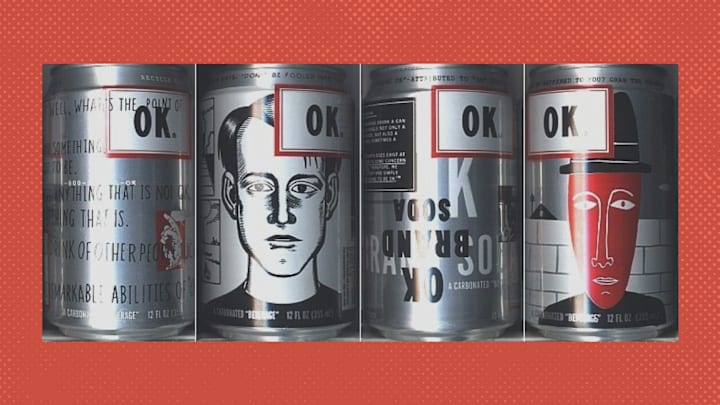“This stuff tastes like crap,” the caller said.
In 1994, Coca-Cola invited consumers to phone an 800 number to leave their candid comments about OK Soda, a new product the beverage giant was test-marketing. Authentic reviews from callers were recorded on the hotline—even if they happened to be disparaging. Unlike Coca-Cola’s flagship product in their iconic red containers, OK Soda cans were in grayscale and emblazoned with art from alternative comic book creators as well as sardonic slogans. The flavor was also quite different.
OK Soda was positioned to be a cola for Generation X, which marketing experts perceived as jaded, anxious, and borderline nihilistic. Those characteristics were therefore baked into the drink; a move Coke believed would help them gain even more ground in a teen soft drink market worth $3 billion. But would that cynical demo be convinced there was such a thing as ironic capitalism?
A Grunge to Bear
Coca-Cola had, of course, experienced one major branding disaster in 1985. That’s when the company’s vaunted New Coke debuted, eliciting groans from fans who disliked the taste and demanded the return of Coca-Cola Classic.
In a bold move, Coke rehired the executive who headed up New Coke, Sergio Zyman, in 1993, tasking him with another maverick campaign.
For OK Soda, Coke wouldn’t be replacing their signature drink, just supplementing it. Part of their justification was that there was only one word or phrase more recognizable in the world than Coke: OK. The term seemed to be a match for what the company’s years-long research identified as mass anxiety among young people aged 12 to 25. OK Soda would, in turn, offer guarded optimism. Things would not be made great simply by glugging OK Soda, but they might be all right, or reach a state of what ad agency Wieden + Kennedy called “OK-ness.”
The can itself had to embody the premise of this muted enthusiasm. When focus groups failed to decide on a favorite design, Coke decided to go with four of them. One was by comic book artist Daniel Clowes, whose graphic novel Ghost World later became a movie released in 2001. Clowes’s can depicted a teen in several panels expressing various degrees of angst.
“Don’t be fooled into thinking there has to be a reason for everything,” the can read. Others featured art by Charles Burns, David Cowles, and Calef Brown.
“We’re trying to capture the irony they live with,” Brian Lanahan, director special projects for Coca-Cola, told Time in 1993. “What we’re trying to show with those symbols is someone who is just being, and just being OK.”
For Clowes, however, the task was to maintain his counterculture sensibility, not conform. “I knew full well that what they were trying to do was not possible, that you could not market to cynical hipsters by being cynical and hipsterish,” he told Believer in 2014. To make his point, Clowes drew his can character so he vaguely resembled cult leader Charles Manson.
Canned Response
OK Soda was released in eight trial markets in the spring of 1994, including Boston and Seattle. It was less a soft drink than a marketing campaign in search of a flavor. Coca-Cola hoped the irreverence would be a selling point. The 800 number (800-I-Feel-OK) received and replayed voicemails from consumers. The company also circulated a chain letter encouraging the recipient to pass it along. Its closing message: “Whatever your problems, please remember: Things are going to be OK.”
(The campaign would sometimes contradict itself: “What’s the point of OK? What’s the point of anything?” one can read.)
Coke also played with the trope of ads associating consumerism with happiness. It highlighted coincidences that befell OK Soda drinkers. “I started drinking OK two days after my boyfriend and I broke up, and ever since I started drinking it, bad things happened to him,” one caller said. “He even broke his leg. That’s pretty good.”
While marketing is critical, it can’t overcome an inherent flaw in the product. For OK Soda, it was the fact that its recipe seemed as dystopian as the ad campaign. The flavor was said to be a mix between conventional dark soda and lemon-lime, or what regional marketing director Annis Lyles described as all of Coke’s products in one can.
This wasn’t necessarily appealing. One caller described it as “carbonated tree sap.” Others compared it to the revolting, overly sweet concoction one gets when pushing all the buttons on a soda fountain dispenser at once.
By fall 1994, it was clear OK Soda was not OK. Distributors began pulling it from shelves over poor sales; one Minneapolis-area retailer told The Washington Post he had failed to sell even a single 12-pack. By fall 1995, Coca-Cola was ready to throw in the towel. It had sold just 1 million cases, a paltry number by the standards of the soft drink market.
Gloom was certainly viable in the 1990s, as proven by grunge. But in the case of OK Soda, it wasn’t something anyone wanted in a can.
